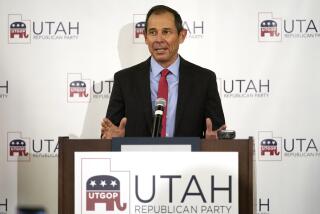Reinventing Kyoto
AS PRESIDENT BUSH sat across the table last week from European leaders steamed about his approach to global warming, he could at least bask in the knowledge that even though the compromise he engineered isn’t exactly the right thing to do, it’s less wrong than usual.
Bush, the former Texas oilman who is as beloved by environmentalists as Nero was by Christians, has been under pressure from a Democratic Congress and fellow world leaders in the Group of 8 to change course on climate change. And he did, sort of. The final communique from the G-8 summit in Germany commits the U.S. to “seriously consider” cutting its greenhouse gas emissions in half by 2050 and to work with the U.N. to come up with a successor to the Kyoto Protocol, the international treaty on climate change that the Senate refused to ratify in 1998. That’s not the deal for mandatory cuts the Europeans were seeking, but it’s further than Bush has been willing to go before.
Bush is correct about one thing: Kyoto is a mess. The president has rightly forced other world leaders to address one of the major flaws of the pact, which is that it doesn’t apply to emerging economic giants such as China and India. Yet he also seems to think that these developing countries should be held to the same standards as the U.S., and is unwilling to do anything unless China does the same. That’s unrealistic and unfair.
A better approach would be to fix what’s really wrong with Kyoto.
What’s so magical about 1990?
The Kyoto Protocol’s main mechanism for saving the world is a cap-and-trade system. Individual countries or confederations set caps on emissions of greenhouse gases based on where they were in 1990 — in the European Union, it’s 8% below 1990 levels — and pass out credits to power plants and industrial polluters, dictating how many tons they can emit. Polluters that fall below their allocations can sell their “carbon credits” to those that can’t reduce emissions as easily.A carbon-trading market for these credits has emerged in Europe, but the scheme so far has done nothing to reduce emissions because, thanks to the power of the energy lobby, the initial credit allocations were set too high. But that barely touches the surface of Kyoto’s problems.
The choice of 1990 as a base year simply rewards countries whose economies have shrunk since then and punishes growth. Russia, Eastern Europe, Germany and Britain are strong backers of Kyoto, and if one looks at the costs and benefits of the pact, it’s no wonder. Today, these countries emit either less than they did in 1990 or just a little bit more. In Britain, that’s because the privatization of the coal industry led to a decline in coal-fired power plants in favor of natural gas; elsewhere, it’s because the collapse of the Soviet Union was followed by the closing of filthy Soviet-era industrial plants, while economies in Russia and much of Eastern Europe stagnated.
The U.S. economy, meanwhile, has grown significantly since 1990, with a corresponding rise in power demand that, according to the Energy Information Administration, has caused carbon dioxide emissions to jump 20.4%. What a global carbon-trading scheme boils down to, then, is a massive wealth transfer from the U.S. to Russia. U.S. polluters would pay billions of dollars to buy carbon credits from other countries — mostly Russia, because it would have the most to sell. Why should we inject huge sums into a country with a rotten human rights record, rampant corruption and opposing geopolitical views? And what did Russia do to earn the cash, other than shrink?
Further, because there is no world body that polices greenhouse gas emissions, countries and polluters are on the honor system — we have to trust them to be honest about how much they’re polluting. Governments in Russia or Ukraine aren’t capable of monitoring emissions from every pollution source even if they wanted to, and under Kyoto, there’s no reason for them to want to. After all, if Ukraine claims to be cleaner than it really is, rich countries such as the U.S. and Japan will shower it with money for carbon credits. And corrupt governments will tend to distribute credits unfairly, using them to reward political supporters and reducing the market’s effectiveness.
Meanwhile, an even bigger problem than the ill-considered carbon-trading scheme is figuring out what to do with those nations that don’t have to take part in it.
Cars, coal and China
Just 40 countries are required to reduce emissions under Kyoto, and because the U.S. and Australia didn’t ratify the pact, it’s only 38. Those countries aren’t necessarily the world’s richest, nor the biggest emitters; they include many poverty-ridden former Soviet-bloc countries such as Estonia, Lithuania and Ukraine. The pact excludes wealthy Asian and Middle Eastern nations such as South Korea, Taiwan, Qatar and Kuwait.Why the distinction? The poor Eastern European countries were eager to take part, knowing they stood to make a lot of money on carbon credits. Meanwhile, many wealthy countries were excluded on the basis of historical fairness: Because they didn’t become economic powers until relatively recently, they aren’t considered as culpable in the buildup of greenhouse gases that started in the 19th century.
Also left out are India and China. A quick look at the increase in greenhouse gas emissions in China alone is headache inducing. If China keeps growing at its current rate, its per capita income is expected to reach U.S. levels within 25 years. Once that happens, the Earth Policy Institute projects, there might be three cars in China for every four people, which is the current ratio in the U.S.; that comes to 1.1 billion vehicles. Currently, there are only 800 million vehicles in the entire world.
Meanwhile, China builds a new coal-fired power plant every week to stoke its growth, and the International Energy Agency calculates that in a quarter of a century, its CO2 emissions will be double those of the other industrialized nations combined. India, the world’s fourth-biggest polluter, is also growing at a blistering pace. Unless these two countries can be persuaded to embrace green power, they will render Kyoto and every other attempt to reduce greenhouse gases moot.
Unfortunately, they’re not eager to change their ways. Last Monday, China unveiled its climate-change plan in response to pressure from the G-8; it made no commitments to any quantifiable carbon reductions and rejected international efforts to impose them. India also refuses to consider anything that might slow its economic development.
That’s no reason to give up, however.
Free-market fix
The week before the G-8 summit, Bush announced that he would call together the 15 nations most responsible for greenhouse gas emissions to hammer out a voluntary deal on lowering them. Implied in that plan was a rejection of the United Nations process that created the Kyoto Protocol and is now focusing on a successor for it after it expires in 2012. Also implied was that the U.S. would only go as far as China and India in making cuts.That’s wrongheaded on many levels. There is something to the historical fairness argument. China and India didn’t create this problem, the older industrial powers did. Further, Americans remain far and away the biggest energy hogs on Earth — yearly per capita CO2 emissions are many times higher in this country than in China or India. We are in a vastly better position to cut emissions without derailing our economy and will never persuade the developing world to come along unless we lead by example.
What’s needed is a new, improved version of Kyoto that brings India and China onboard and commits them to “grow green,” but still leaves the tougher cuts up to those nations better able to make them, such as the U.S., Canada, Japan and Europe. A better treaty would scrap the unworkable carbon-trading scheme and instead impose new taxes on carbon-based fuels. As recently explained in the first installment of this series, carbon taxes avoid many of the pitfalls of carbon trading. They would produce an equal incentive for every nation to clean up without relying on arbitrary dates or caps, or transferring money from one nation to another. They’re also much less subject to corruption because they give governments an incentive to monitor and crack down on polluters (the tax money goes to the government, so the government wins by keeping polluters honest).
Of course, China and India would be no more eager to accept carbon taxes than carbon caps. But the free market has a way of accomplishing what no amount of international pressure can.
As clean-power technologies and alternative fuels become more widely available, which a carbon tax would encourage, they will get cheaper. China and India both care more about raising standards of living than about pollution or global warming, but that doesn’t mean they don’t care at all. Waterways are becoming badly polluted in both countries, and the air in many big Chinese cities is nearly unbreathable. Coal is abundant and cheap in China, but if the price of renewable power were competitive, the Chinese would buy it. Yet green power will never reach this price unless the U.S. and other industrialized nations crack down much harder on carbon.
Real solutions to global warming, such as carbon taxes, won’t come cheap — they’ll make power bills steeper and gas prices even higher than they are now. But the economic news isn’t all bad. Much of the clean technology of the future will probably be developed in the United States and sold overseas. Think of it as a novel way of reducing our trade deficit with China while building a cleaner world.
More to Read
A cure for the common opinion
Get thought-provoking perspectives with our weekly newsletter.
You may occasionally receive promotional content from the Los Angeles Times.






